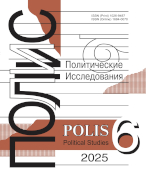The Idea of Mongolian Civilization as a Concept of a Multipolar World Order
Litvinova T.N.,
Dr. Sci. (Pol. Sci.), Associate Professor of State, Municipal Administration and Social Processes Department, Odintsovo Campus of MGIMO-University, MFA of Russia, tantin@mail.ru
elibrary_id: 368821 |
DOI: 10.17976/jpps/2017.05.13
Litvinova T.N. The Idea of Mongolian Civilization as a Concept of a Multipolar World Order. – Polis. Political Studies. 2017. No. 5. https://doi.org/10.17976/jpps/2017.05.13
Alexandr Zhelezniakov’s “Mongolian Civilization: History and Modernity. Theoretical Justification of the Atlas,” based on the achievements of modern civilization theory, offers a concept for the development of the Atlas of Mongolian civilization. The work uses extensive theoretical and factual material, revealing the features of the identification and development of Mongolia as the core of the civilization of Inner Asia (Mongolian civilization) with ancient and rich history and culture. The author successively reveals the phases of development of the Mongolian civilization on the way to the modern “breakdown” and the transition to a new phase – the acquisition of Mongolia’s political and economic independence, civilizational identification, and positioning in a complex and contradictory world order. The author of the monograph not only characterized the potential of the Mongolian civilization on the way to becoming a pole of a new world order, but also proposed a new methodological approach at the intersection of civilization theory and geopolitics. For the first time in studying the problems of world politics, the researcher posed topical issues of self-identification in the world historical process of local civilizations that overlap each other with their orbits. The monograph represents Mongolia as a pole of the civilization of Inner Asia, which is in interaction with the European, Russian, Chinese, Hindu and Islamic civilizations, which is included in the orbits of all foreign policy poles of world influence, but is not dissolved in them. The monograph gives a theoretical background for the creation of a system of maps integrated in the Atlas of the Mongolian civilization.
References
Huntington S. The Clash of Civilizations. (Russ. ed.: Huntington S. Stolknoveniye tsivilizatsiy. Moscow: AST. 2003. 603 p.)
Mongolyn tuhay VKP(b) Namyn barimt bichigt [Mongolia in the Documents of the AUCPB]. Vol. 1 (1920-1932). 2002. Ulaanbaatar. 560 p.
Toynbee A.J. Comprehension of History. (Russ. ed.: Toynbee A.J. Postizheniye istorii. Мoscow: Progress. 1991. 736 p.)
Zhelezniakov A.S. Mongol’skaya tsivilizatsiya: istoriya i sovremennost’. Teoreticheskoye obosnovaniye atlasa. [Mongolian Civilization: History and Modernity. Theoretical Justification of the Atlas]. Moscow: Ves Mir Publishers. 2016. 288 p.
See also:
Rodionov V.A.,
Mongolia we never knew. – Polis. Political Studies. 2011. No4
Zheleznyakov A.S.,
Subjects of Modern World Arrangement: the Nomadic Mongolia. – Polis. Political Studies. 2009. No4
Lukin A.V.,
Russia and China in Greater Eurasia. – Polis. Political Studies. 2020. No5
Utkin A.I.,
Energy resources and geopolitics. – Polis. Political Studies. 2010. No3
Litvinova T.N., Zheleznyakov A.S., Chuluunbaatar G.,
The challenges of modernity in the Mongolian world. – Polis. Political Studies. 2022. No4




.jpg)






 print
print
.jpg)
.jpg)